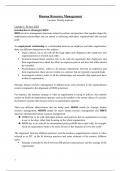Human Resource Management
Lecturer: Wendy Andrews
Lecture 1: 03 nov 2023
Introduction to (Strategic) HRM
HRM involves management decisions related to policies and practices that together shape the
employment relationships and are aimed at achieving individual, organizational and societal
goals
An employment relationship is a relationship between an employee and their organization,
there are different dimensions to this relation:
Legal contract, has to do with all the legal rights and obligations that employees and
organizations have towards each other
Economic/transactional contract, has to do with the agreement that employees and
their organization have about the effort an employee puts in and how that effort should
be rewarded
Psychological contract, refers to all mutual expectations between an employee and
their organization, these are not written in a contract, but are typically expected deeds
Sociological contract, refers to all the relationships and networks that employees have
within an organization
Strategic human resource management in addition pays extra attention to the organizational
context compared to the alignment of HRM (practices).
For instance; the business strategy is what an organization is trying to achieve, the external
context in which an organization operates such as the market or the norms/values of a society,
the business systems that focuses on how an organization operates.
There are different abbreviations that are being used: SHRM stands for strategic human
resource management, MHRM stands for micro human resource management and IHRM
stand for international human resource management
MHRM has to do with individual policies and practices that an organization is trying
to use or develop, rather than focusing on the whole organization
IHRM has to do with all the international policies HRM has to deal with, for example
when an organization wants to be more diverse or has branches all over the world
The alignment between different practices and the business organizational context is often
referred to as FIT, so the fit between practices and some elements of the context, different
types:
Strategic (vertical) fit, the fit between HR policies and practices and the strategy of the
organization
1
, Internal (horizontal) fit, the fit between HR policies and practices and other HR
policies and practices, if all the policies and practices of an organization fit with each
other
Organizational fit, the fit between HR policies and practices and other organizational
systems, for instance with IT systems or procedural systems
Environmental or institutional fit, the fit between HR policies and practices with
legislation, norms and management fashions, institutional context of an organization
In HRM there is a difference between the best practices approaches and the best fit
approaches.
In a best practice approach what you’re trying to do is identify the best way to do things
within your organization. If you tailor the practices you use to fit as well as possible to the
context in which you operate than you’re following a best fit approach
Best fit is based on the premise that picking the most effective HR policies depend on
matching them appropriately to the organization’s environment, like the strategy scan,
find the best fitting practices
The best practice approach focuses on a prescriptive set of practices, this is a universal
approach, finding the best practices
Identifying the very best way to do HR practices and policies and bringing them to an
organization, for example adopting the best recruitment procedure from another
company, like high performance work systems or Pfeffer’s seven best practices
Jeff Pfeffer suggested these 7 practices as common themes seen in successful organizations:
Employment security
Selective hiring of new personnel
Self-managed teams and decentralization of decision making as the basic principle of
organizational design
Comparatively high compensation contingent on organizational performance
Extensive training
Reduced status distinctions and barriers, including dress, language, office
arrangements and wage differences across levels
2
, Extensive sharing of financial and performance information throughout the
organization
So, for the best practice approach, the organizations systems and practices are considered
beforehand and then implemented, whereas for best fit, the organizational strategy comes first
and all organizational systems and practices follow.
The HR strategy scan is an example of a best fit approach. The HR strategy scan is a
systematic way to evaluate HR policies and practices and the organizational context
By carrying out an internal evaluation, the most important opportunities, bottlenecks
and improvement points become visible
An organization gains direct insight into its internal HR policy
Employers can use the results of the scan to achieve their strategic goals and improve
where possible
Different business models/approaches
The Rhineland approach, a management approach based on concepts of cooperation,
consensus, social justice, serving the interests of multiple stakeholders and employee
wellbeing and societal interests
The Anglo-American or Anglo-Saxon approach, this governance model prioritizes
shareholder return, shareholder participation and minimal bureaucracy, it focuses
mainly on shareholder value (profit, market value)
Strategic balances approach, believes that success can only be achieved when
financial performance and societal performance of an organization are above average
in the particular population in which the organization is operating
Lecture 2: 06 nov 2023
SHRM and SEMCO HR Strategy Scan
3





